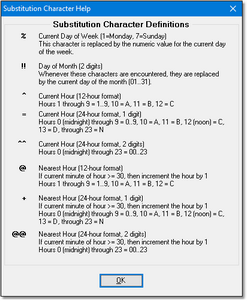To use substitution characters in a Map Output Name, enter the appropriate character as a part of the Output Name. The Audio Import Map dialog provides a pop-up button to display a substitution character help window, similar to the one shown.
Supported Substitution Characters
Macro |
Usage |
|---|---|
% |
Current Day of Week (1=Monday .. 7=Sunday) |
!! |
Day of Month (2 digits) |
^ |
Current Hour (12-hour format) Note: Because this is a 12-hour format, the current hour value used when substituting for this macro character can occur twice during the day. For instance the 10 AM and 10 PM hours will return the same value - "A". |
= |
Current Hour (24-hour format, 1 digit) Using this macro character format, there are no duplicates throughout the day. |
^^ |
Current Hour (24-hour format, 2 digits) |
@ |
Nearest Hour (12-hour format) Note: Because this is a 12-hour format, the current hour value used when substituting for this macro character can occur twice during the day. For instance the 10 AM and 10 PM hours will return the same value - "A". |
+ |
Nearest Hour (24-hour format, 1 digit) If current minute of the hour >= 30, then the returned hour value is incremented by 1. Hours 0 (midnight) through 9 = 0..9, 10 = A, 11 = B, 12 (noon) = C, 13 (1 PM) = D through 23 (11 PM) = N Using this macro character format, there are no duplicates throughout the day. |
@@ |
Nearest Hour (24-hour format, 2 digits) Hours 0 (midnight) through 23 = 00..23 |
Day of Week Values
The day of week macro character returns a numeric value, based on the current day of the week. Values returned are shown in this table.
Day |
Value |
|---|---|
Monday |
1 |
Tuesday |
2 |
Wednesday |
3 |
Thursday |
4 |
Friday |
5 |
Saturday |
6 |
Sunday |
7 |
Hour of Day Values - 1 & 2 Digits
Hour of Day macro characters will return different one-character values, depending on the specific macro character used. The main differences occur between any 12-hour format and any 24-hour format. Values returned by each format type are listed in this table.
Hour of Day |
12-Hour Format |
24-Hour Format |
24-Hour Format |
|---|---|---|---|
Midnight |
C |
0 |
00 |
1 AM |
1 |
1 |
01 |
2 AM |
2 |
2 |
02 |
3 AM |
3 |
3 |
03 |
4 AM |
4 |
4 |
04 |
5 AM |
5 |
5 |
05 |
6 AM |
6 |
6 |
06 |
7 AM |
7 |
7 |
07 |
8 AM |
8 |
8 |
08 |
9 AM |
9 |
9 |
09 |
10 AM |
A |
A |
10 |
11 AM |
B |
B |
11 |
Noon |
C |
C |
12 |
1 PM |
1 |
D |
13 |
2 PM |
2 |
E |
14 |
3 PM |
3 |
F |
15 |
4 PM |
4 |
G |
16 |
5 PM |
5 |
H |
17 |
6 PM |
6 |
I |
18 |
7 PM |
7 |
J |
19 |
8 PM |
8 |
K |
20 |
9 PM |
9 |
L |
21 |
10 PM |
A |
M |
22 |
11 PM |
B |
N |
23 |
Substitution Character Examples
Here are some examples of how substitution characters can be used, along with an explanation of the results.
Example |
Result Description |
|---|---|
WX@@ |
This example uses the 2-digit nearest hour substitution characters. If processing occurs at 3:07 AM, the resulting file name is: WX03 |
WEX% |
This example uses the day of week substitution character. If processing occurs on a Monday, the resulting file name is: WEX1 |
WX%= |
This example combines the day of week and current hour in 24 hour format substitution characters. If processing occurs at 5:07 AM on a Monday, the resulting file name is: WX15 |
WXX^ |
This example uses the current hour in 12 hour format substitution character. If processing occurs a 11:15 AM, the resulting file name is: WXXB |
WX!! |
This example uses the day of month substitution character. If processing occurs on the 5th day of the month, the resulting file name is: WX05 |
When using substitution characters, ensure the resulting file name meets the requirements of the system you will be using to play back the audio.
